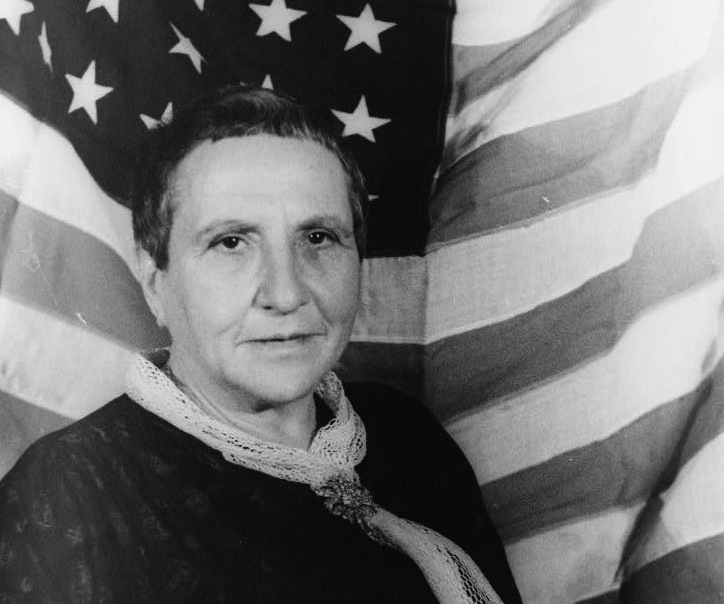Let's take a close look at how White writes about Stein:
PARAGRAPH ONE: (Introductory paragraph)
Tender Buttons, Gertrude Stein’s collection of experimental still-life word portraits split into the categories of objects, food, and rooms, and which—excluding a vanity publication in 1909, which she paid for herself—was the first of Stein’s work to be published in the United States. Stein had hoped that this enigmatic little book would be her big break, the thing to convince the American people of her genius. That was not to be. Tender Buttons left critics bemused and made barely a dent on the consciousness of the wider reading public. There was no great clamor for more of her writing; Stein would have to wait another twenty years to become a household name. Nevertheless, the publication of Tender Buttons is now widely regarded as a landmark in American literary modernism, the moment when one of the most influential writers of the twentieth century first unfurled her avant-garde sensibilities before the American public.
PARAGRAPH TWO: (Right after introductory paragraph)
That moment would never have arrived had it not been for the work of Stein’s most important champion, Carl Van Vechten, the man who arranged for the book’s publication. Little remembered today, Van Vechten was a pioneering arts critic, a popular author of tart, brittle novels about Manhattan’s Jazz-Age excesses, an acclaimed photographer, and a flamboyant socialite whose daring interracial cocktail parties were a defining part of Prohibition-era New York’s social scene. But his greatest legacy is as a promoter of many underappreciated American writers, artists, and performers who went on to gain canonical status. Names as diverse as Langston Hughes, Paul Robeson, and Herman Melville all felt the effects of Van Vechten’s boost. His first great cause was Gertrude Stein. He did more than anyone else to carve her legend into the edifice of the American Century, arranging publishing deals for her, photographing her, and publicizing her work, a task he continued long after her death.
BODY PARAGRAPH: (8th paragraph overall)
Van Vechten did a better job of bringing Stein’s writing to public attention with an article, “How to Read Gertrude Stein,” published in the fashionable arts magazine The Trend in August 1914. As the double meaning of the title suggests, it was intended to be an insider’s guide to understanding Stein’s work as well as her personality, framing Van Vechten as the man with an all-access pass to the great enigmatic genius of the age. Always a more assured critic of music than of literature, Van Vechten turned to musical referents for his most effective explanations of Stein’s writing, a tactic that countless others have followed in the intervening century. “She has really turned language into music,” he asserted; “Miss Stein drops repeated words upon your brain with the effect of Chopin’s B Minor Prelude.” The article also helped to develop and solidify Stein’s image as a guru-like figure, the sort of character Jo Davison would capture in his famous sculpture of Stein as Buddha some years later. “As a personality Gertrude Stein is unique,” Van Vechten wrote. “She is massive in physique, a Rabelaisian woman with a splendid thoughtful face; mind dominating her matter.” Stein wrote her charge to let him know that she was “very well pleased with your article about me.”
BODY PARAGRAPH: (14th paragraph overall)
When he got the chance to photograph Stein during her tour, Van Vechten made sure he did so in a way that took her public image to a new level of grandeur. In Virginia, he shot her in front of neoclassical buildings, including the Rotunda designed by Thomas Jefferson, deliberately placing her within the pantheon of historic American heroes. Once again their shared instinct for myth creation kicked in; they both understood that this was the moment in which Gertrude Stein would achieve her immortality. Touring America, she saw the history of the nation more vividly than ever before, and she sensed her place within it. When she passed through Dayton, Ohio, she noted to Van Vechten that this was where the Wright Brothers had started out; Marion, Ohio, she learned excitedly, was Warren Harding’s hometown. From Illinois she wrote Van Vechten breathlessly, urging him to “make a pictorial history of these United States and I will write one and we will all be so happy.”
FINAL PARAGRAPH: (17th paragraph overall)
When Stein died in 1946, it was to Papa Woojums [Van Vechten] that she left the task of getting her large number of unpublished manuscripts into print, the measure of her respect and affection for him. Despite fearing that “Gertrude had bitten off more than I could easily chew,” Van Vechten faithfully undertook his duty. Within a little more than a decade, Stein’s complete works had been published.

No comments:
Post a Comment